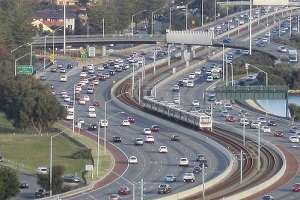Cardiac arrest linked to air pollution

HIGH air pollution levels are linked to an increase in the rate of cardiac arrest, according to a study of St John Ambulance call-outs in Perth.
The research found that an increase in particulate matter smaller than 2.5 microns (PM2.5) was associated with a more than 10 per cent increase in the risk of out-of-hospital cardiac arrest.
High carbon monoxide levels were also associated with a significantly higher risk.
The study looked at 8551 cases of out-of-hospital cardiac arrest in the metropolitan area attended by paramedics between 2000 and 2010 and correlated them with hourly air pollution levels recorded at seven monitors.
It found interquartile range increases in the 24 and 48-hour averages of PM2.5 were associated with 10.6 per cent and 13.6 per cent increases in the risk of cardiac arrest respectively.
Ambulance data presented in the paper shows call-outs for cardiac arrest peak at about 10am, with a second, smaller peak about 6pm.
But Monash University research fellow Lahn Straney, who authored the study, says the effect is too great to be attributed to pollution levels alone.
"Actually Monday at 9am is the worst, so it can be partly stress-related," he says.
"If you look at the levels of pollutants, it kind of corresponds with traffic time as well."
Cardiac arrest is when the heart stops pumping blood, as opposed to a heart attack, which refers to a blockage in the heart.
The fatality rate for out-of-hospital cardiac arrest is about 90 per cent.
Dr Straney says the increased risk due to air pollution is from a low baseline but there were implications for people at high risk.
"A lot of carbon monoxide comes from traffic pollution and PM2.5 is affected by traffic but also burning of things, so burning wood, bushfires and things like that," he says.
"If we think of people that are at high risk, so older people typically, you really don't want to be building nursing homes, you don't want to be having hospitals on major roads."
Dr Straney says at-risk people could also be made aware of air pollution levels so they could choose to stay indoors on days when PM2.5 spiked, such as during bushfires.
Between 2000 and 2010 there were 1464 occasions when the Perth monitors recorded pollution levels exceeding acceptable limits set by the National Air Quality Standards, according to the study.
Dr Straney says the effect of air pollution on cardiac arrest is likely be stronger than reported because it is difficult to accurately measure people's personal exposure to pollution.
More information:
Evaluating the impact of air pollution on the incidence of out-of-hospital cardiac arrest in the Perth Metropolitan Region: 2000-2010.
Straney L, Finn J, Dennekamp M, Bremner A, Tonkin A, Jacobs I. J Epidemiol Community Health. 2013 Sep 17. DOI: 10.1136/jech-2013-202955.















